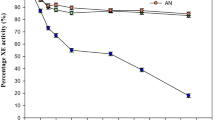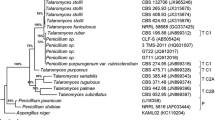Abstract
The aim of this work was to make a survey describing factors that influence the production of extracellular enzymes by white-rot fungus Ceriporiopsis subvermispora responsible for the degradation of lignocellulolytic materials. These factors were: carbon sources (glucose, cellulose, hemicellulose, lignin, maltose and starch), nitrogen sources (ammonium sulphate, potassium nitrate, urea, albumin and peptone), pH, temperature and addition of three different concentrations of Cu2+ and Mn2+. The cellulase and xylanase activities were similar in medium with different carbon sources and the highest cellulase and xylanase activities were measured in medium with urea and potassium nitrate as nitrogen sources, respectively. The highest laccase activity was observed in medium with lignin and peptone as carbon and nitrogen sources. In other experiments, time course of production of lignocellulolytic enzymes by white-rot fungus C. subvermispora in medium with lignin or glucose as carbon sources was observed.
Similar content being viewed by others
References
Bailey M.J., Biely P. & Poutanem K. 1992. Inter-laboratory testing of methods for assay of xylanases activity. J. Biotechnol. 23: 257–270.
Barr D.P. & Aust S.D. 1994. Pollutant degradation by white-rot fungi. Rev. Environ. Contam. Toxicol. 138: 49–72.
Beg Q.K., Kapoor M., Mahajan L. & Hoondal G.S. 2001. Microbial xylanases and their industrial applications: a review. Appl. Microbiol. Biotechnol. 56: 326–338.
Blanchette R.A., Burnes T.A., Eerdmans M.M. & Akhtar M. 1992. Evaluating isolates of Phanerochaete chrysosporium and Ceriporiopsis subvermispora for use in biological pulping processes. Holzforschung — Int. J. Biol. Chem. Phys. Technol. Wood 46: 109–115.
Cohen R., Hadar Y. & Yarder O. 2001. Transcript and activity levels of different Pleurotus ostreatus peroxidases are differentially affected by Mn2+. Environ. Microbiol. 3: 312–322.
Collins P.J., Field J.A., Teunissen P. & Dobson A.D. 1997. Stabilization of lignin peroxidases in white rot fungi by tryptophan. Appl. Environ. Microbiol. 63: 2543–2548.
de Souza-Cruz P.B., Freer J., Siika-Aho M. & Ferraz A. 2004. Extraction and determination of enzymes produced by Ceriporiopsis subvermispora during biopulping of Pinus taeda wood chips. Enzyme Microb. Technol. 34: 228–234.
Evans C.S. & Palmer J.M. 1983. Ligninolytic activity of Coriolus versicolor. J. Gen. Microbiol. 129: 2103–2108.
Fan L.T., Gharpuray M.M. & Lee Y.H. 1987. Cellulose Hydrolysis (Biotechnology Monographs). Springer, Berlin, 198 pp.
Gao J., Weng H., Daheng Z., Yuan M., Guan F. & Xi Y. 2008. Production and characterization of cellulolytic enzymes from the thermoacidophilic fungal Aspergillus terreus M11 under solid-state cultivation of corn stover. Biores. Technol. 99: 7623–7629.
Hammel K.E. & Cullen D. 2008. Role of fungal peroxidases in biological ligninolysis. Curr. Opin. Plant Biol. 11: 349–355.
Heidorne F.O., Malgalhaes P.O., Ferraz A.L. & Milagres A.M.F. 2006. Characterization of hemicellulases and cellulases produced by Ceriporiopsis subvermispora grown on wood under biopulping conditions. Enzyme Microb. Technol. 38: 436–442.
Howard R.L., Abotsi E., Jansen van Rensburg E.L. & Howard S. 2003. Lignocellulose biotechnology: issues of bioconversion and enzyme production. Afr. J. Biotechnol. 2: 602–619.
Kirk T.K. & Cullen D. 1998. Enzymology and molecular genetics of wood degradation by white-rot fungi, pp. 273–308. In. Young R.A. & Akhtar M. (eds), Environmentally Friendly Technologies for the Pulp and Paper Industry, University of Wisconsin, Wisconsin, USA.
Levin L., Herrmann C. & Papinutti V.L. 2008. Optimization of lignocellulolytic enzyme production by the white-rot fungus Trametes trogii in solid-state fermentation using response surface methodology. Biochem. Eng. J. 39: 207–214.
Lowry O., Rosenbrough N., Farr A. & Randall R. 1951. Protein measurement with the Folin reagent. J. Biol. Chem. 193: 265–275.
Miller G.L. 1959. Use of dinitrosalicylic reagent for the determination of reducing sugar. Anal. Chem. 31: 426–428.
Olsson L., Christensen T.M.I.E., Hansen K.P. & Palmqvist E.A. 2003. Influence of the carbon source on production of cellulases, hemicellulases and pectinases by Trichoderma reesei Rut C-30. Enzyme Microb. Technol. 33: 612–619.
Rajakumar S., Gaskell J., Cullen D., Lobos S. & Vicuna R. 1996. Lip-like genes in Phanerochaete sordida and Ceriporiopsis subvermispora, white-rot fungi from which lignin peroxide has not been detected. Appl. Environ. Microbiol. 62: 2660–2663.
Saravanakumar K., Saranya R., Sankaranarayana A. & Kaviyarasan V. 2010. Statistical designs and response surface technique for the optimization of extra cellular laccase enzyme production by using Pleurotus sp. Recent Res. Sci. Technol. 2: 104–111.
Sánchez C. 2009. Lignocellulosic residues: biodegradation and bioconversion by fungi. Biotechnol. Adv. 27: 185–194.
Sethuraman A., Akin D.E. & Eriksson K.E.L. 1998. Plant-cellwall-degrading enzymes produced by the white-rot fungus Ceriporiopsis subvermispora. Biotechnol. Appl. Biochem. 27: 37–47.
Tanaka H., Koike K., Itakura S. & Enoki A. 2009. Degradation of wood and enzyme production by Ceriporiopsis subvermispora. Enzyme Microb. Technol. 45: 384–390.
Vincentim M.P. & Ferraz A. 2007. Enzyme production and chemical alterations of Eucalyptus grandis wood during biodegradation by Ceriporiopsis subvermispora in cultures supplemented with Mn2+, corn steep liquor and glucose. Enzyme Microb. Technol. 40: 645–652.
Author information
Authors and Affiliations
Corresponding author
Rights and permissions
About this article
Cite this article
Chmelová, D., Ondrejovič, M., Ondáš, V. et al. Influence of cultivation conditions on production of lignocellulolytic enzymes by Ceriporiopsis subvermispora . Biologia 66, 748–754 (2011). https://doi.org/10.2478/s11756-011-0103-5
Received:
Accepted:
Published:
Issue Date:
DOI: https://doi.org/10.2478/s11756-011-0103-5




